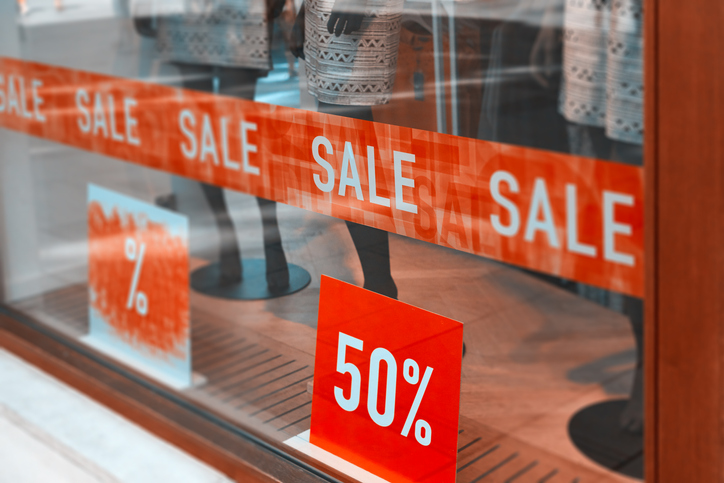How often have you walked past a store that seems to be permanently plastered top to bottom in red and white bunting screaming, “SALE”? For some, the sale never seems to end.
Thanks to the rise of e-commerce and tech savvy shoppers adept at finding the best price possible, more businesses appear to be operating within this “always on sale” environment. People are shopping differently to the way they did in the past. Research shows that 81 per cent of shoppers do online research before committing to the purchase, while 89 per cent begin their buying process with a search engine. And brands are responding to this shift with discounts, coupon codes or sales, to grab the attention of shoppers doing their research. You need look no further than Amazon’s recent Prime Day for a perfect example.
Of course, there are plenty of good reasons for offering a discount. The corresponding bump in sales, the clearance of old stock or an influx of new customers all make an intoxicating rationale for cutting your prices more often.
But these are only short-term benefits. In the long term, running more sales and competing on price alone makes you increasingly reliant on smaller and smaller returns.
Put simply, it’s not sustainable.
Instead, you should be focusing on your customers, to drive consistent growth and an audience that will stick with you for a lifetime.
The customer comes first
You need to break the cycle. But how?
As Steve Jobs said, “You’ve got to start with the customer experience and work backwards to the technology. You cannot start with the technology and try to figure out where you are going to sell it.”
In other words, get the customer stuff right and then worry about everything else.
According to the KPMG Global Retail Trends 2018 report, customer experience will overtake price and product as the key brand differentiator by the year 2020. With more choice than ever before, both online and offline, customers will go wherever offers the best experience – and they’re willing to pay more for it.
In fact, research from PWC shows that 42 per cent of consumers said they would pay more for a friendly, welcoming experience, and 52 per cent would pay more for efficient customer service. It’s why Scentre Group’s director of customer experience, Phil McAveety, recently vowed: “We can’t just be in the shopping centre business anymore.” Because while discounts and sales might get one-off customers in the door, it’s the overall experience that will keep people coming back and spending more with you.
A unique experience
Nike, the world’s largest supplier of athletic shoes and apparel, has been doing things differently since it started in 1964 as Blue Ribbon Sports. And in typical fashion, the sportswear giant brought disruptive thinking to its new flagship retail store in New York and offered a truly unique customer experience. Alongside a mini-basketball court, soccer enclosure, a treadmill and a system that simulates runs in different locations, the store features personalisation areas where customers can choose and customise their sneakers.
Nike has also made a real effort to combine online and offline shopping in the flagship store. By scanning a code in-store using the Nike app, a customer can have items brought directly to a fitting room, eliminating the need to chase the attention of an assistant. The Nike app also features Nike Instant Checkout, giving customers the ability to pay for purchases without having to stand in line at a checkout.
Australian department store Myer has undertaken its own spin on unique customer experience by signing a partnership with retail technology company LiTMUS Labs. The collaboration will see Myer customers play with new premium consumer electronics in a ‘try before you buy’ setting at LiTMUS Labs in stores located in Melbourne, Brisbane and Sydney.
Apple is another leading light in customer experience, but for different reasons. While the stores are well designed, the real secret to the Apple Store experience is its staff. Instead of concentrating on selling, Apple Store staff are focused on building a relationship with the customer. The staff and the way they deal with customers are the centre of the experience thanks to the Apple steps of service, a series of enquiries or interactions taught to staff to make the customer feel special. It clearly works, with Apple the world’s top retailer in sales per square foot.
Scaling tactics to fit your business
It isn’t just big retailers that can offer customers something unique instead of just slashing prices. Something as simple as focusing your money and resources towards exceptional customer support, and giving your shoppers a stellar experience, will earn you a customer for life. After all, it’s five times more expensive to attract a new customer than it is to retain one.
You could also target your marketing messaging on the right channel at the right time. Reach customers when they feel happy to hear from you, instead of annoying them with a cold call or email newsletter that interrupts their day and gets ignored or deleted. Asking for customer feedback is another great way to continually refine and improve the experience – and makes customers feel that their feedback and wellbeing really matters to your brand.
The end game
The retail industry is becoming more and more competitive, and brands need to do something special to stand out. It’s not enough to just keep lowering prices and expecting that will draw customers in – you need to be thinking first and foremost about what the customer wants and how you can deliver this in an experience that is not only unique but engaging and enjoyable.
Customers are clearly willing to pay for great customer service. Although the above examples may be considered outliers, they’re proof that if you offer something special to the customer, they’ll bring their business to you, helping you break away from the perpetual sale trend.
By Brendan Straw, Chief Customer Officer, Ovato

